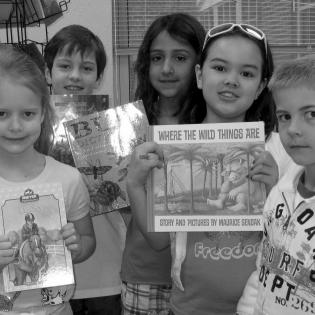Helping Others
Through discussion of the book The Seven Chinese Brothers, learners recognize that using our talents and working together to help others has benefits greater than the opportunity cost (what we gave up to take generous action).
The learner will:
- identify the benefit and opportunity cost of helping others.
- take action to help others by sharing talents.
- read-aloud copy of the book, The Seven Chinese Brothers
- world map
Mahy, Margaret. The Seven Chinese Brothers. New York: Scholastic, Inc., 1990. ISBN: 0590420577
Instructions
Anticipatory Set:
Introduce the book "The Seven Chinese Brothers" as an old tall tale from China. On a map, show China on the continent of Asia. Explain that the story takes place during the reign of the powerful Emperor Ch’in Shih Huang, between the years of 259-210 B.C. This emperor was responsible for having the Great Wall of China built. Building the wall was dangerous work that killed and hurt many thousands of workers. In this story, seven talented brothers attempt to help the suffering workers.
Read The Seven Chinese Brothers aloud. Talk about the tall tale elements of the story that describe the talents of the seven brothers (ears that hear a fly sneeze from a hundred miles away, bones like iron, etc.).
Talk about the exaggerations that describe the emperor (face is more dazzling than the rising sun, whisper like the rumble of thunder, glance like a flash of lightning). Talk about what these descriptions tell us about the emperor and how people perceive him.
Optional: Give the young people time to make up tall-tale descriptions that exaggerate their own talents and then illustrate or share them verbally with the group. The facilitator can model this first.
Discuss why the brothers chose to help the workers with the wall. How did they use their talent to help?
What was the cost to each brother personally for helping? Was the cost too great? The "opportunity cost" is what they gave up in order to make the choice to help. Was the outcome worth the choice to sacrifice?
In this story, the brothers worked well together. Each talent alone was great, but in the story, none of them could have survived alone without the talents of the others. Discuss what the youth can do to bring their time and talents together for the common good.
Brainstorm things the young people can do to help others on their own or as a group using their talents and resources. Make and carry out a plan to do something for an individual or for the common good. List the steps, resources, and outcomes of the plan.
Philanthropy Framework
-
Strand PHIL.I Definitions of Philanthropy
-
Standard DP 01. Define Philanthropy
-
Benchmark E.4 Define and give examples of selfishness and selflessness.
-
-
Standard DP 02. Roles of Government, Business, and Philanthropy
-
Benchmark E.6 Explain why acting philanthropically is good for the community, state, nation, or world.
-
-
-
Strand PHIL.II Philanthropy and Civil Society
-
Standard PCS 02. Diverse Cultures
-
Benchmark E.4 Demonstrate listening skills.
-
-
-
Strand PHIL.III Philanthropy and the Individual
-
Standard PI 01. Reasons for Individual Philanthropy
-
Benchmark E.1 Describe one reason why a person might give or volunteer.
-
Benchmark E.9 Give examples how people give time, talent or treasure in different cultures.
-
-
